Janine Erler is a star of Danish cancer research. She is professor at the University of Copenhagen, group leader at the university’s Biotech Research and Innovation Centre (BRIC) and member at the Royal Danish Academy of Sciences and Letters. Her earlier research led to the discovery of the key role of the enzyme lysyl oxidase (LOX) in hypoxia-induced cancer metastasis, postulated during her research stay in Stanford University in USA, in her seminal Nature paper 12 years ago, Erler et al Nature 2006. Next year, the entrepreneur Erler co-founded the company Arresto Biosciences, ready to market an LOX inhibitory antibody simtuzumab. A phase 1 clinical trial began, and in 2010 the business was sold to the pharma giant Gilead for $225mn. The clinical trial on 32 patients completed in 2012, unfortunately Dr Erler and her clinical collaborators were too busy to post any results or publish any papers about the outcomes. It was assumed however that LOX inhibition by simtuzumab “led to reduction in size of several solid tumors”. Even before that phase 1 trial completed, phase 2 on 250 patients with with metastatic pancreatic adenocarcinoma began, and ended in 2015. Yet for some reason, the LOX inhibitor suddenly proved no more effective than a placebo (Benson et al 2017), meaning it had no effect whatsoever. In November 2016, Gilead dropped the product completely. Not the first time when many millions get wasted in clinical research just because something was published in Nature. Never mind the burdens and false hopes given to patients.
In 2008, Erler was group leader at the ICR London (known for highly creative cancer research) and in 2012, she moved her lab to BRIC. In 2016, the European elite funding institution European Research Council (ERC) recognised the potential of Erler’s innovative approach to scientific discoveries and awarded her with €2mn Consolidator grant for 5 years. Without false modesty, Dr Erler is not just a very successful businesswoman and celebrated scientist, but she has also been very close to curing cancer. Until some sad envious bad-wishers found duplicated gel bands in her papers.
Luckily, neither BRIC nor ERC were bothered. When I received two dossiers with evidence of data manipulation, I tried to send them to ERC Standing Committee on Conflict of Interests, Scientific Misconduct and Ethical Issues, but I was made to understand that I am not welcome. Just like the ERC press office, the members of the committee refused to reply to my emails. Incidentally, the head of that Committee and ERC Vice-president is the Danish chemist Klaus Bock, senior executive with Danish beer maker Carlsberg and the Danish National Research Foundation. Which probably means that Denmark’s star scientist Janine Erler not only has friends in high places, but also free beer.
See update below that Stanford University has closed the case in June 2019.
My emails to Bock and his Committee colleagues offering an Erler dossier went unanswered. I did not include ERC president Jean-Pierre Bourguignon because I already figured out he probably doesn’t understand the concept of research integrity, likely due to his background as a CNRS executive.
ERC operates on the principle of absolute research excellence, and apparently the ignoble deed of data manipulation and research misconduct is something an ERC grant recipient cannot engage in, by definition. Thus, if ERC funded scientists are found guilty of research misconduct by their own university, ERC politely pretends it didn’t happen and continues paying out the hefty cash, just like ERC presently keeps doing for the cheater Maria Fousteri. This is also why ERC was the only major funder which continued financing Olivier Voinnet when others deserted him, and this is why ERC kept the grant of zombie scientist Susana Gonzalez suspended for a long time, probably hoping she still might find herself a new lab to fake data in. That grant had to be terminated eventually, just as that of Pontus Boström when he was made to leave academia. Jacob Hanna was even rewarded by a second ERC grant, despite the evidence of data manipulations in his papers which ERC saw as forgivable sins of innocent youth. All these cases are described here.
What ERC funded researchers are apparently expected to do is to publish more papers in Nature or similar, how they do it is their own business. This is why one can scream till blue in the face about the reused and manipulated blots in papers of recently funded ERC grantee Carlos Lopez-Otin: at ERC it will meet on deaf ears. And of course same is true for Erler, as I was made to understand by Bock and his colleagues.
In 2017, Erler educated early career researchers in a Danish science magazine on “How to be a top scientist today”, on her own example.
“While there are no easy fixes, and success can be measured differently by different people, I believe there are some basic principles which will put any young scientist within reach of the ‘top scientist’ accolade. […]
Scientific excellence depends on a high level of energy and dynamism, an insatiable appetite to understand life, and an almost super-human efficiency to juggle everything while maintaining focus. Not to mention, a powerful ability to communicate with your peers and to fight with reviewers. Not for the faint-hearted!”
That text impressed the member of the Nobel Committee for Physics Mats Larsson so much that he even said about Erler:
“One can say that her description forms a baseline for winning a Nobel Prize.
Earlier this year 2018, Erler’s ex-husband Rune Linding, also professor at University of Copenhagen, approached Retraction Watch with a dossier from the HEADT Centre (by Humboldt University Berlin and Elsevier) which analysed the Erler et al Nature 2006 paper and strengthened suspicions of data manipulation. The dossier was originally commissioned by Humboldt researcher Edda Klipp. A former colleague of Erler’s shared another dossier with me (Dossier 2), which I publish here and discuss below.
The first dossier I received though (Dossier 1 can be found here) was sent to me by yet another reader of my site. It also contains collected PubPeer evidence for other papers on LOX in tumorigenesis, from Erler’s and other labs. One can see that already as PhD student in Manchester Erler had a peculiar disregard for proper gel loading controls. Her paper Erler et al, Mol Cell Biol 2004 hides from the reader the fact that despite the intended appearance, the samples were not run on the same gel. It is not a trivial or minor issue: a professor in Vienna, Richard Morrigl, recently had to learn the rules of good scientific practice with western blots.
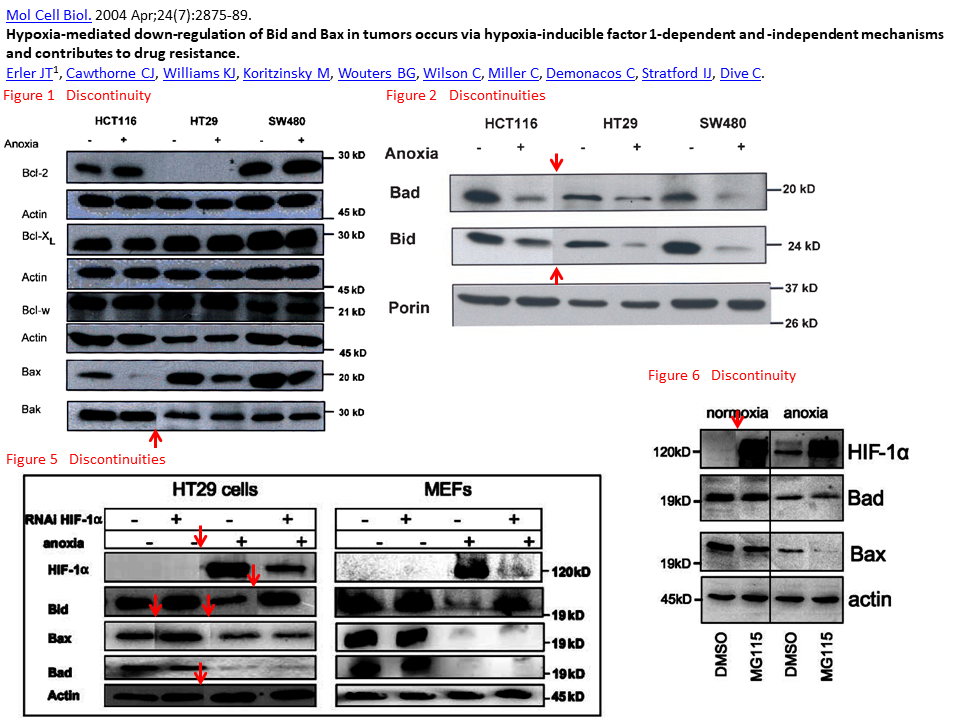
The Dossier 2 focusses on Erler’s decisive paper which made her career as elite scientist and biotech entrepreneur: Erler et al Nature 2006.
In the final version of that Nature 2006 paper, Erler postulated an effect of LOX on the activity of another enzyme, focal adhesion kinase (FAK), which is required for cancer cells to become mobile and to metastasise. Where LOX protein is downregulated, FAK phosphorylation disappears and the FAK enzyme becomes inactive, which provides an elegant mechanism on how a LOX inhibitor could potentially prevent cancer metastases and save millions of lives. Those Erler results are supported by convincing laboratory data, demonstrated in the Figure 4. Or so one thinks. Here is the evidence already available on PubPeer and presented in the first dossier.
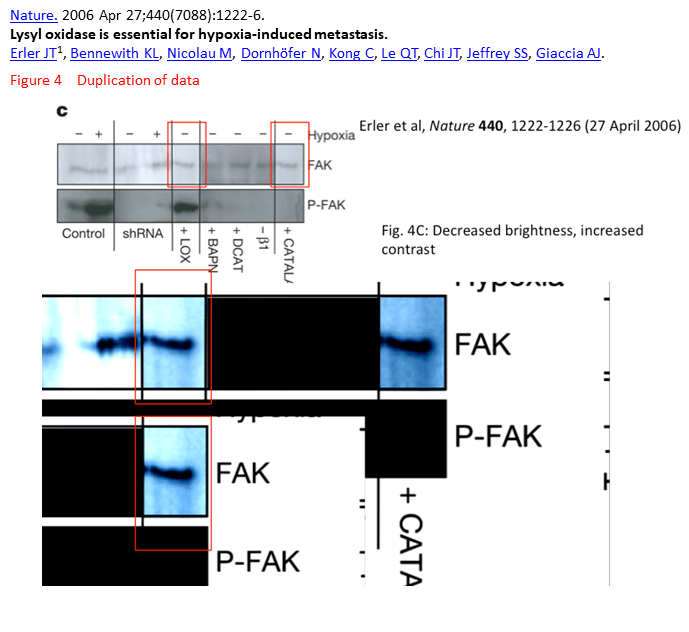
Why did the authors of the Erler et al Nature 2006 saw the need to duplicate gel bands? Wasn’t the data solid, reproducible and supported, as stated in the paper, by all the controls and parallel experiments (“data not shown”) as well as “consistent with previous reports”? Not necessarily. As the 2nd dossier indicates, some recovered FAK western blots from August 2004 show no signal whatsoever, even when the analysis was repeated. The gels were completely empty. Yet according to same dossier, when Erler gave a lecture in Oxford one year later, in August 2005, the convincing results were already available, the gel existed almost in the same form as it later appeared in Nature. Almost, but not quite. That gel namely started growing additional lanes, prompted by reviewer criticisms. Back when the paper was submitted, the Figure 4 used to be Figure 5, but it did not yet contain any FAK data. The submitted manuscript was criticised by peer reviewers for lacking a mechanistic explanation, and this is how FAK regulation by LOX came to happen.
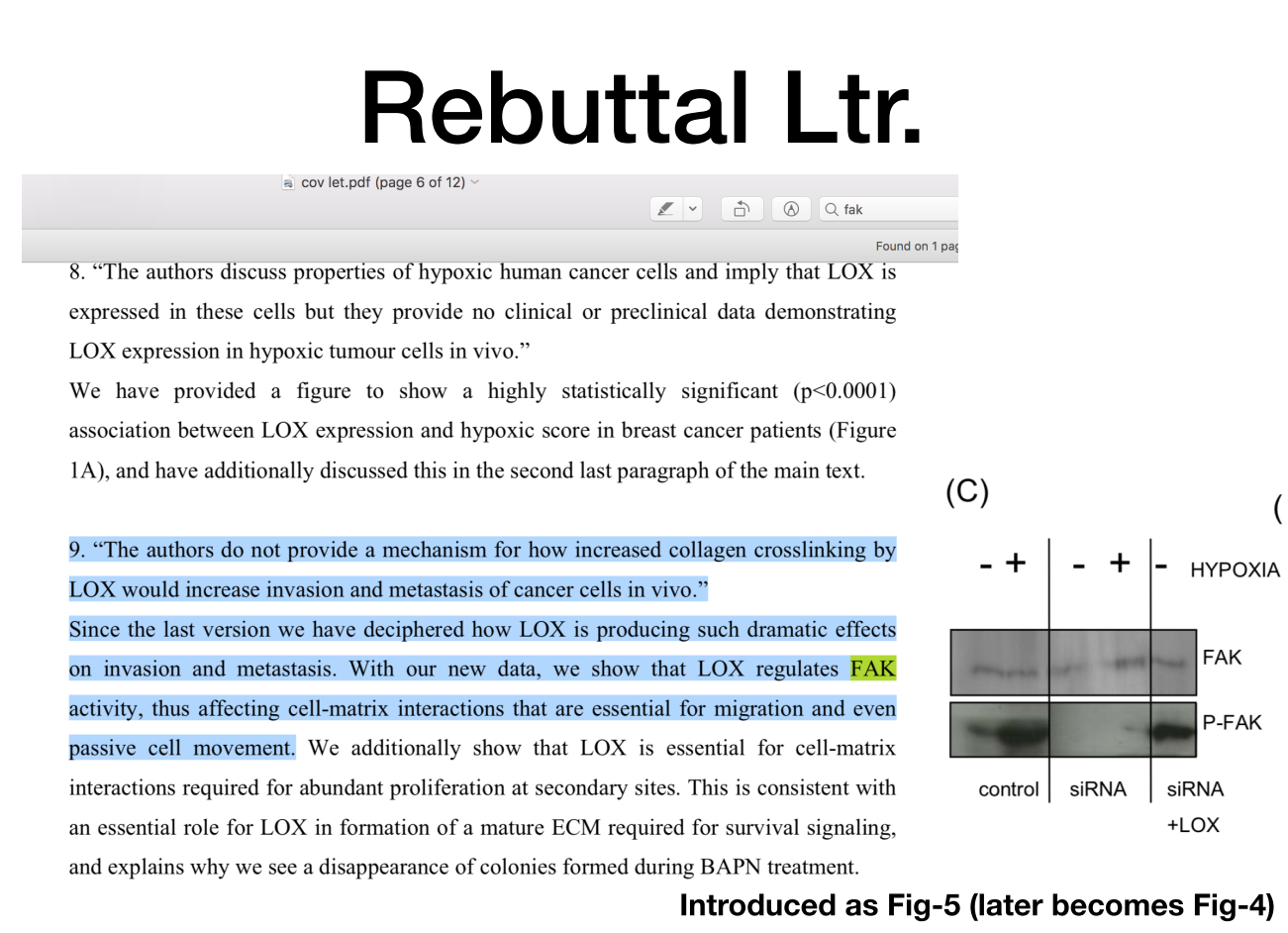
In September 2005, Erler sent her first rebuttal letter to peer reviewers at Nature, an excerpt of which is shown in the figure. The reviewers were now presented with some freshly generated data, namely the regulation of FAK activity by LOX. Yet they remained unconvinced that the changes in FAK activity were really due a specific effect from LOX on extracellular matrix. This is why when Erler resubmitted the manuscript again, the reviewers saw exactly same gel grow 3 additional lanes, which proved a role for the extracellular protein beta-1-integrin in the LOX-FAK interaction. Western blots normally do not grow extra lanes. The picture of the 3 new lanes was simply stuck onto the old one.

Note that the experiment was not repeated, with additional samples, as would have been appropriate. The 3 lanes were ran on a separate gel months later, and simply digitally spliced onto others, made to look as one continuous gel. Consider also: the 3 new lanes showing the absent phospho-FAK signal were physically separate from the gel where the other results and, most importantly, the positive controls were. That being the most elite scientific journal in the world, the Nature reviewers did not mind such LOX, pardon, lax attitude to controls, reproducibility and image integrity. They did have other minor issues though before the paper was accepted.
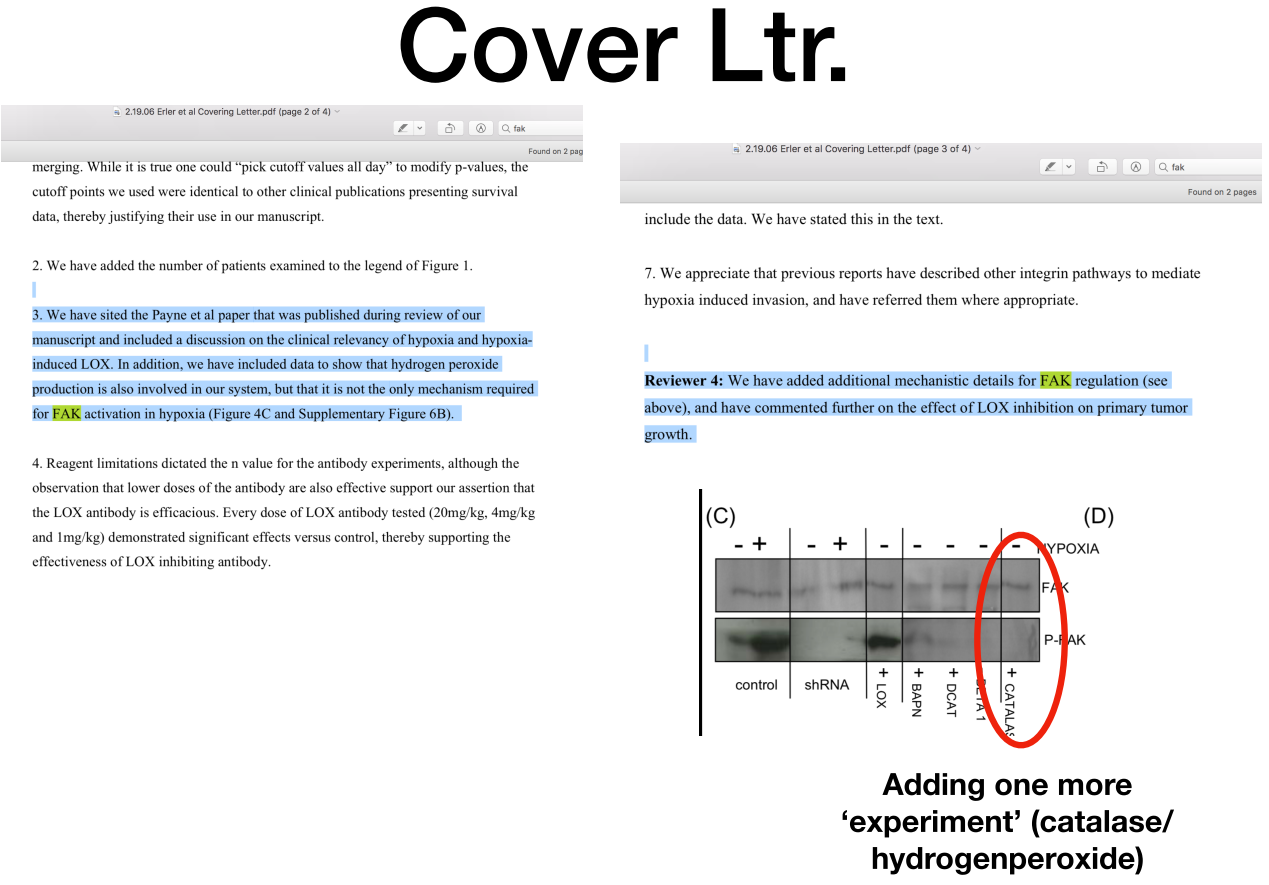
The reviewers still were not sure if LOX is really the key regulator of FAK and metastasis, as proposed by Erler. They pointed out some recent publication on the role of hydrogen peroxide which is produced during hypoxia. No problem, Erler’s gel grew another lane featuring a peroxide experiment with Catalase to satisfy the reviewers. So now there were two new gels, both showing no phospho-FAK signal, spliced onto the old gel where the positive control for phospho-FAK signal was present. How did the reviewers know those two gels were ever probed with a working phospho-FAK antibody (remember Erler’s empty gels from 2004)? They trusted her, and so must the scientific community reading Nature, who were led to believe the new Figure 5 shows one continuous gel. It is however anything but.
This is what Figure 4 really consists of, when one accesses the original figure and pulls apart the separate puzzle bits of gel pictures:
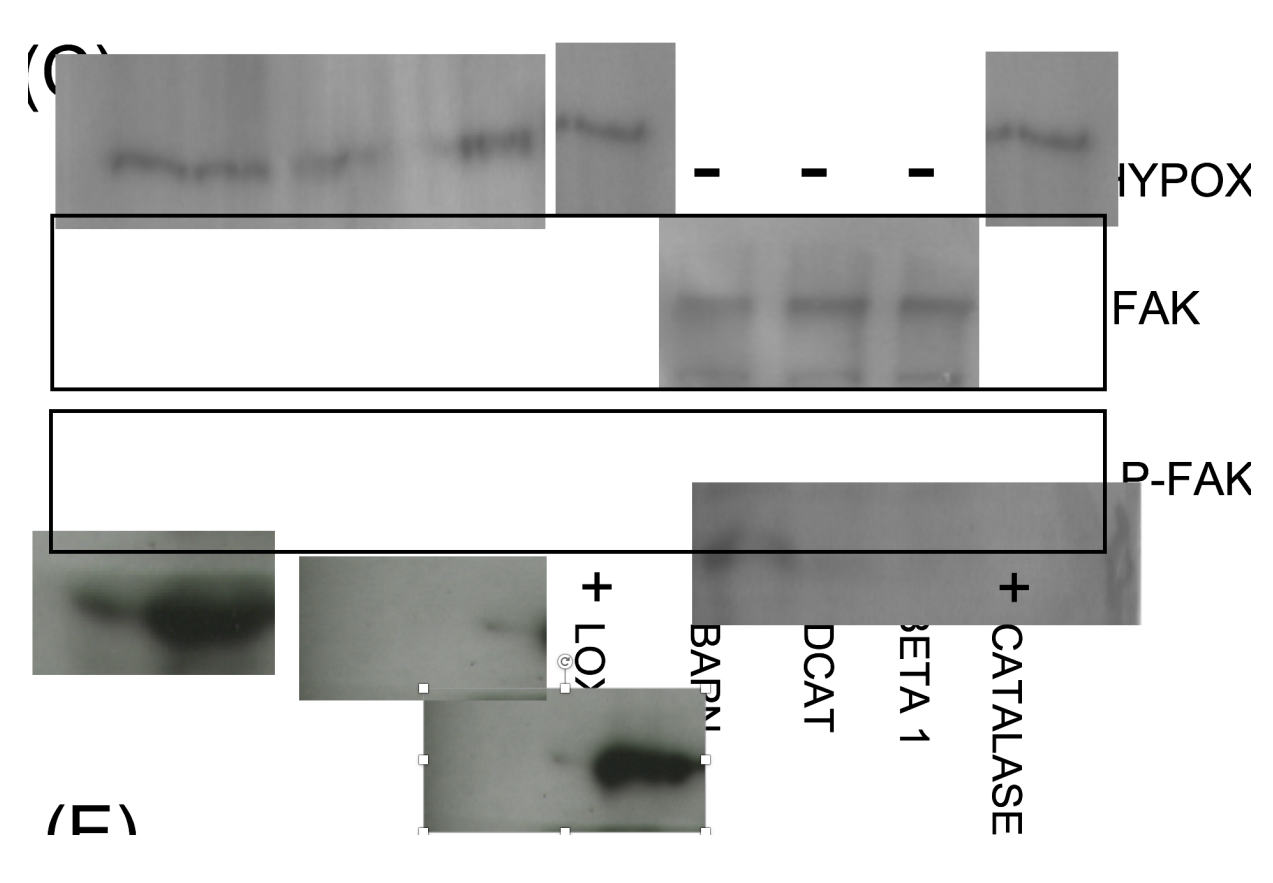
Nothing matches anything. The total FAK and phospho-FAK bands come from all over the place, but no two pieces look like they ever were on the same gel. The positive controls for phospho-FAK came from a different gel as everything else. And the rebuttal data of FAK proves as phoney. The phospho-FAK band for last Catalase experiment is just the extension from the previous rebuttal, before the relevant paper was even mentioned and the experiment was requested of Erler. Also the main data points, siRNA for LOX and resupplied +LOX can’t be trusted to have come from correct experiments. But that’s not all. There are also as we know band duplications. Even more than the professional HEADT analysts found.
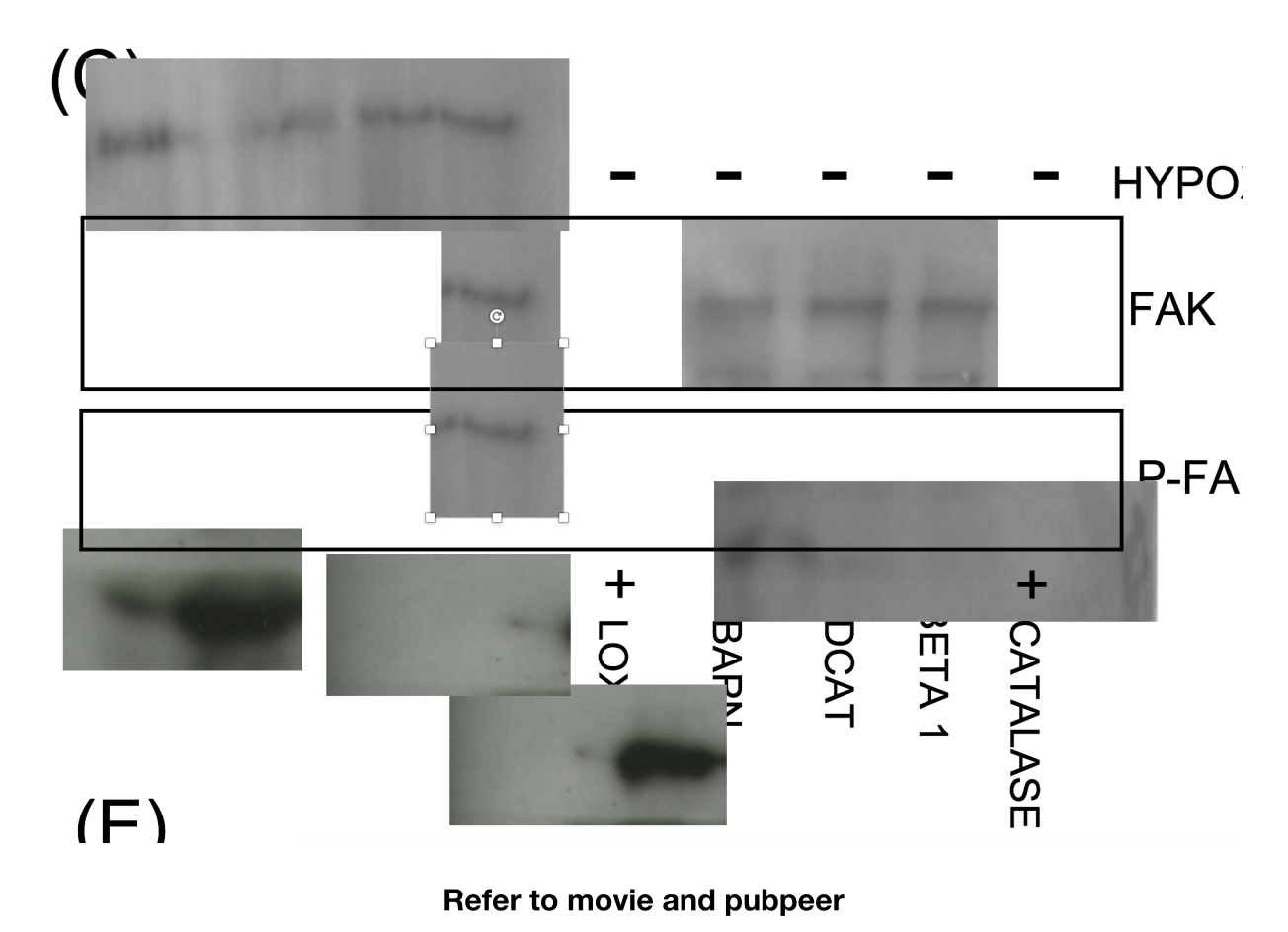
The same band of total FAK appeared initially twice: as +LOX and as catalase. But now we see its real origin: it used to be the first hypoxia-free control band, rotated.
And in case you were still hoping that at least some of the bands might have been showing the phospho-FAK antibody signal from that LOX experiment: not likely. These scans of old western blots provide evidence:
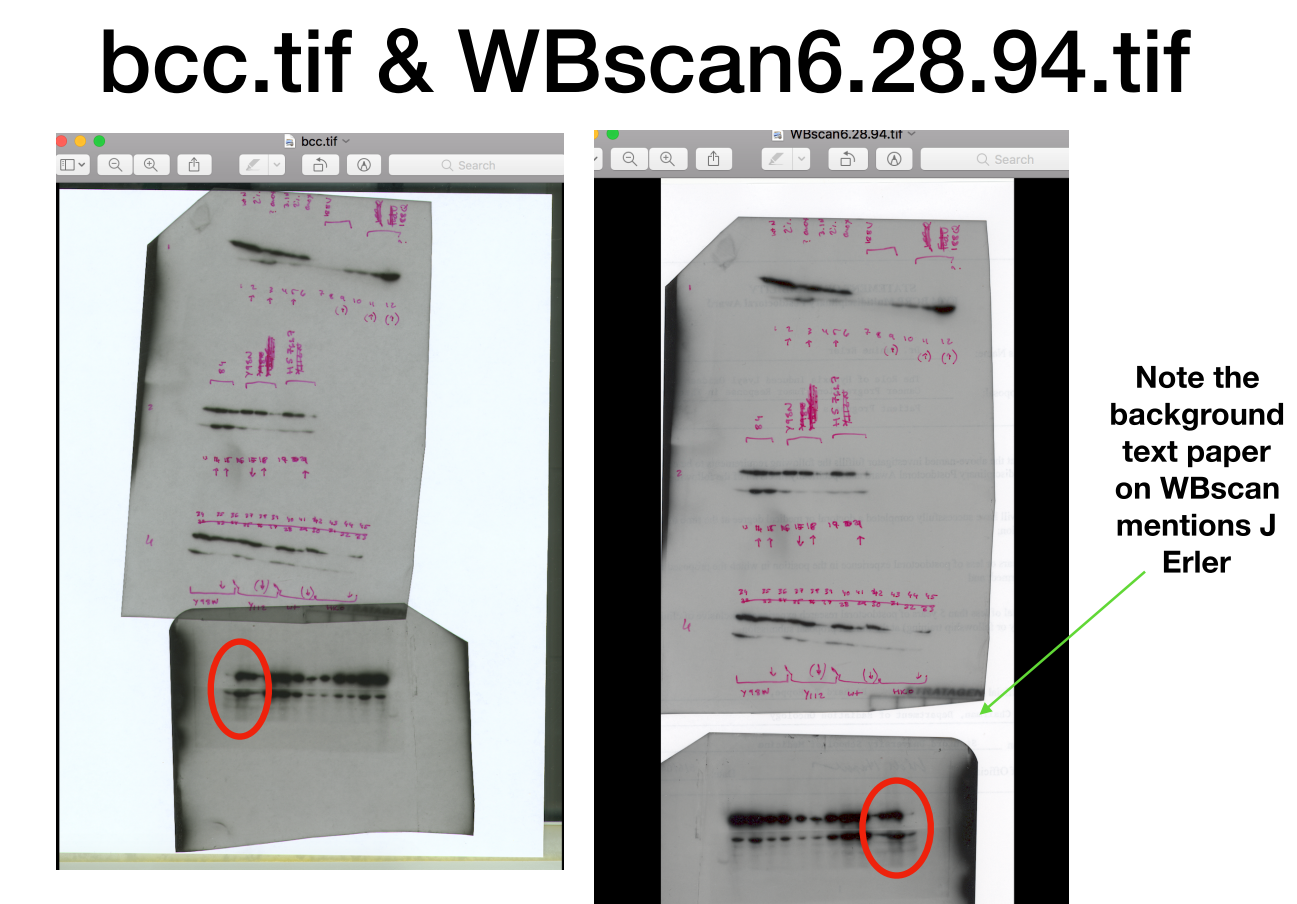
The microbiologist Elisabeth Bik is also an image integrity expert and has a unique talent for detecting duplicated image fragments. Her work was decisive in uncovering a fraud case at a pharma giant Pfizer, which featured on my site. Bik now analysed the Figure 4c and those old gel images from 2004, and this is what she found:
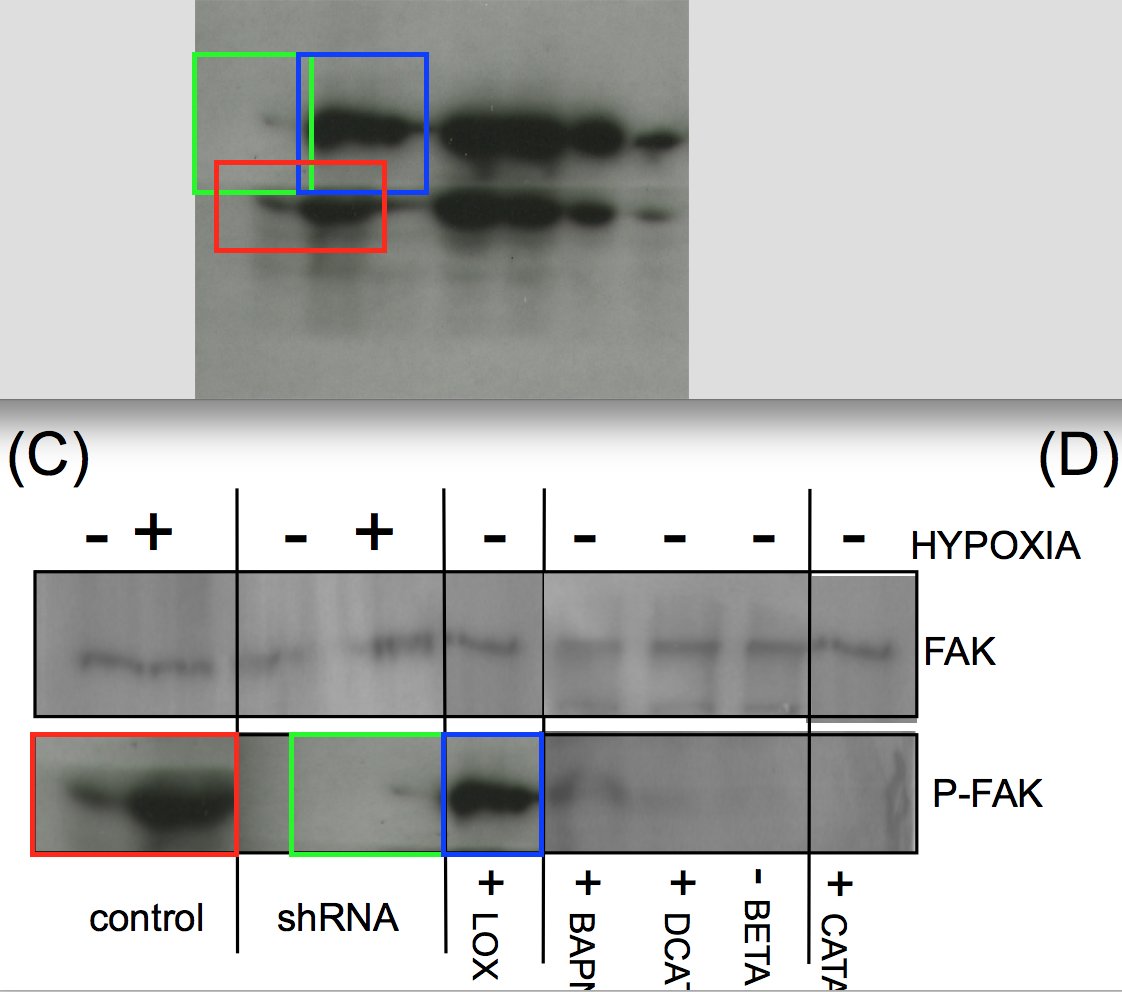
The “phospho-FAK” bands attributed to the two control samples and to the two shRNA samples as well as the “+LOX” existed already in 2004 and were originally labelled as something completely different. It is not clear what exactly (something about some VHL mutants Y98N), but it is rather sure that those 2004 experiments, attributed to Erler, had nothing to do with FAK. It even seems that one fat “+LOX” phospho-FAK band from the Nature paper used to be two adjacent bands in that old 2004 gel.
The former lab colleague sums up in the Dossier 2:
“Primary data do exist (contrary to Stanford Investigation)
Main finding of FAK figure (P-FAK band for +LOX) is fabricated:
Taken from experiment irrelevant to FAK or LOX (VHL mutants Y98N)
Bands used for control and +LOX experiment from the same lane (physical impossible given the claim is different conditions). Experiment performed ~1 year before request for it by the external reviewers
Other bands clearly duplicates (see attached movie). No change in bands moving from siRNA to shRNA (compare 1st revision w. 2nd). Primary data for other figures also seems available from the “Erler Disk”
Primary data most likely also at Stanford (or deleted by someone?)“
There are more band duplications in this paper, assembled in the Dossier 1.
This is the Nature-quality preclinical research upon which the pharma giant Gilead invested hundreds of millions dollars, and for which cancer patients were recruited to pointless clinical trials and given false hope. All that might have been already prevented had the reviewers asked Erler et al to run all experimental samples and their controls on one single gel, as proper scientists do.
In 2015, when the clinical trial proved that LOX inhibition had no more than a placebo effect on patients, Erler published another paper in Nature: Cox et al 2015. Now LOX grew itself a new role in cancer: Erler’s lab in Copenhagen postulated LOX activity causes bone metastasis, via a novel signalling pathway. The failed inhibitor simtuzumab was given a new life, to work in yet another novel pathway and cure cancer. ERC immediately grabbed the opportunity to advance groundbreaking research in Europe and gave Erler €2mn. Because as Erler already proved to Gilead and anyone else who bothered to watch, a preclinical paper in Nature is gospel and a recipe for a clinical success. Not.
That Cox et al 2015 paper was quickly refuted by other researchers, and it also contains some data irregularities. Again, the loading controls don’t match.

The whole point of loading controls is that they should be probed on exactly the same gel as the other data points. How else can we know that one sample really contained more LOX than the other, if we can not verify if equal amounts of total protein were loaded in each? Because the journal asks authors to upload original data, we see that the original gels don’t match each other: LOX and beta-actin signals stem from physically different gels. Everyone at Nature knew it, but didn’t mind once again. Erler’s story was so nice, you see. Countless cancer patient lives were about to be saved by creative figure assembly.
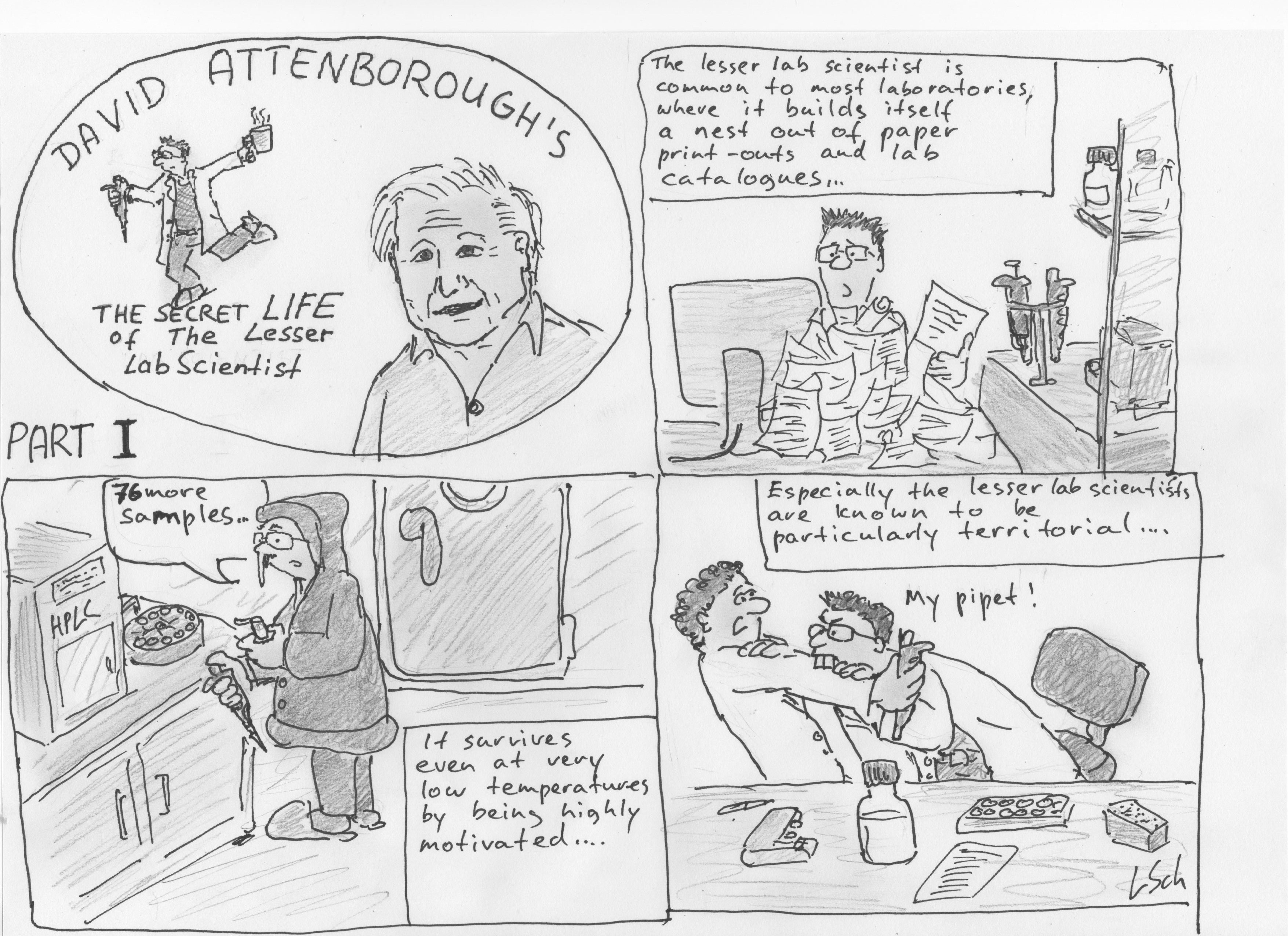
Erler is a star researcher at BRIC, and the institute’s director Kristian Helin has some of his own papers listed on PubPeer, which also contain duplicated gel bands. This might explain why University of Copenhagen and BRIC are so tolerant towards Erler’s gel band troubles. The institutions are however much less tolerant of those who make troubles for Erler. In fact, accidents happen. Things get damaged.
Linding’s BRIC lab, which complained in 2017 to the university about Erler’s research grant management practices, experienced shortly after something truly bizarre from their academic employer. Not a severed horse head in bed, something more original. As a Danish newspaper reported:
“For their experiments, the research group used live cancer cell lines. These cells are meant to be stored frozen at minus 80 degrees, and which therefore requires liquid nitrogen to be supplied on a weekly basis.
But during the course of the conflict-ridden process an administrator at the University cancelled the refuelling. This meant that the temperature rose, and all the cells died, therefore the research group notified the University of vandalism which had their research material destroyed. […]
This was preceded by a controversy about several million Kroner.
The research team received 20 million Kroner grant for cancer research from the State Innovation Fund. The money was obtained when the group was affiliated with the University of Copenhagen Biotech Research & Innovation Center (BRIC).
The connection to the BRIC ran over a fixed period of two years, and since the funding was due to expire in 2017 the team managed to make a deal with Denmark’s Natural History Museum, so the research team was instead able to complete research on the museum’s premises.
But when the agreement was sealed, it appeared that the research team did not have nearly as much money at his disposal as the group had been promised.”
It was the same grant Erler was part of. The issue is now with the Danish courts. But the cell lines are gone forever and can’t be reimbursed. The University of Copehagen’s message is clear.
Update: I now received another dossier by Biovoxxel about Erler et al Nature 2006. It analyses further band duplications .
Update 24.08.2018. I finally managed to get a reply from ERC! Their Press Advisor replied to me today:
“Thank you for your email. The ERC treats seriously any allegations of scientific misconduct and has procedures in place to deal with such cases.”
It is not much, but hopefully a start.
Update 25.09.2019
There is a detailed account of the destruction of research material, published by Nancy Gogh on 30 05.2019 on Medium. I was also privy to an email from Kathy McClelland, Research Compliance Director at Stanford University, addressed to Erler’s ex-husband Linding, who apparently shared with Stanford a hard drive with the original data. The email was send on 30.06.2019:
“At this point, the University has once again concluded that it will close the matter, due to the facts that:
– The article was published 13 years ago;
– The original data are unavailable;
– The information provided by you was not accessible, and of uncertain provenance;
– The data retention period and the applicable statute of limitations for research misconduct matters have expired; and
– The major findings of the paper have been replicated and validated multiple times in the literature.
Under the circumstances here, the University has determined that there are no further actions that would be appropriate or required for it to take, and is therefore closing the matter. “
Erler’s mentor and last author on that 2006 Nature paper, Amato Giaccia, has since left Stanford for UK, to become director of new radiology institute in Oxford. Stanford now makes their biomedical PhD students swear pledge not to fake data, probably as a pre-emptive scapegoating programme.
Update 19.03.2020
The paper Erler et al Nature 2006 has been retracted on 18 March 2020:
“We, the authors, are retracting this Article owing to issues that have come to our attention regarding figure assembly and data availability. Image analysis of the data has showed several image anomalies in Fig. 4c, Supplementary Figs. 1a, e and 4a. Nature has informed us that the quality and integrity of these images are not in line with journal policies. In particular, the panels affected include Supplementary Fig. 4a, which demonstrates that the shRNA construct used in the manuscript induces a reduction of LOX protein. No original data are available for the affected panels or other data included in the manuscript. We believe that the key findings of the paper are still valid as replicated by others. However, given the issues described above and the absence of original data, we have concluded that the most appropriate course of action is to retract the Article. All authors agree with the Retraction.”

Donate!
If you are interested to support my work, you can leave here a small tip of $5. Or several of small tips, just increase the amount as you like (2x=€10; 5x=€25). Your generous patronage of my journalism will be most appreciated!
€5.00






You point out a paper by Erler and Giaccia. Nature. 2006 Apr 27;440(7088):1222-6.
https://pubpeer.com/publications/663C348635341DA0336AB8CB3646BA
Giaccia has another problematic paper in the Nature stable of journals.
Nat Med. 2013 Oct;19(10):1325-30. doi: 10.1038/nm.3294. Epub 2013 Sep 15.
Cross-talk between hypoxia and insulin signaling through Phd3 regulates hepatic glucose and lipid metabolism and ameliorates diabetes.
Taniguchi CM1, Finger EC, Krieg AJ, Wu C, Diep AN, LaGory EL, Wei K, McGinnis LM, Yuan J, Kuo CJ, Giaccia AJ.
Author information
Division of Radiation and Cancer Biology, Department of Radiation Oncology, Center for Clinical Sciences Research, Stanford, California, USA.
https://pubpeer.com/publications/FB7695753BB37D69E5FC65189D8B5D#6
LikeLike
One of papers from the 1st author are retracted….https://retractionwatch.com/2016/11/14/two-harvard-led-groups-pull-well-cited-cancer-papers-for-duplication/
LikeLike
Second paper by first author of Nat Med. 2013 Oct;19(10):1325-30 retracted.
Second retraction mentioned here:
https://retractionwatch.com/2017/04/25/harvard-diabetes-researcher-retracts-third-paper/
http://www.jbc.org/content/291/53/27434
LikeLike
See: http://www.scmfocus.com/criticalthinking/2017/03/glamour-magazine-ways-sexist-article-powerful-women-dress/
At one point the article focuses on Dr. Janine Erler, a cancer researcher. Here quote is as follows:
“For many of us promoting your work to a further audience, networking, especially in the evening is where the stakes get much higher, and women can really trounce men.” Dr. Janine Erler is a highly regarded scientist, who leads a team of eight…in the department of cell and molecular biology at the Institute of Cancer Research. Her work around enzymes is considered globally important and involves a constant stream of scientific breakthroughs, but they require constant fundraising. Erler doesn’t have to try to hard – 5ft 10in with long legs, she cuts a statuesque figure in a lab coat or an evening dress. Last year at a fundraising event for the Royal Marsden Hospital at the Saatchi Gallery, Erler took care to raise the game, enviously beautiful in a floorlength black halterneck dress by Anoushka G. “I like to look very polished for evening events, which are extremely important for our fundraising. But I don’t wear anything too revealing because its still work.” – Glamour
LikeLike
Dossier 1, Mol Cell. 2012 May 11;46(3):369-76.
Retraction Watch reported its retraction.
https://retractionwatch.com/2016/06/29/authors-pull-mol-cell-paper-for-inappropriate-manipulation-of-data/
LikeLike
The Loxipharm.com website is now defaced (http://loxipharm.com).
The BRIC director has left his job and an interim director is now appointed (https://www.bric.ku.dk/contact/):
Interrim Director
Anders H. Lund
Phone: +45 35 32 56 57Call: +45 35 32 56 57
Phone: (Reception desk) +45 353-25666Call: +45 353-25666
E-mail: anders.lund@bric.ku.dk
LikeLike
Hi Leonid,
Excuse my tangent here… but I wonder what made Linding become the ex-husband?
Never underestimate a spurned lover?
Cheers, Oliver
LikeLike
Or do they grown apart?
LikeLike
“Erler is a star researcher at BRIC, and the institute’s director Kristian Helin has some of his own papers listed on PubPeer, which also contain duplicated gel bands.”
I like this one.
https://pubpeer.com/publications/072E660F06F1018E0B12FF7DA9D7D4#5
LikeLike
Apparently Helin has been “demoted” four times: 1. From BRIC director (reporting to the Rector directly) to normal department head in 2016. 2. From vice-dean of KU-Health to nil in 2017. 3. From department head to nil in 2018. 4. From professor to guest professor in 2018. That suggest a problem or two.
LikeLike
That could just mean Helin has a job somewhere else.
LikeLike
He is leaving KU. However it has been a downhill ride since 2016. It is a big deal to transition from independent research director to a dept. head that can not even recruit independently to now nil.
But who cares the story here is about Erler and the misconduct.
LikeLike
Helin is going to head an institute in Memorial Sloan Kettering Cancer Center: https://uniavisen.dk/afskedsreception-for-kristian-helin-der-flytter-til-new-york/
Talk about a “downhill ride” from BRIC to Memorial Sloan Kettering
LikeLike
I am glad that Leonid point out the problem with moving from bench to bed side with just invalid data in the pocket. Unfortunately this story is not at all unique, and there are many ongoing and planned clinical studies which have one thing in common: lack of solid pre-clinical results justifying clinical studies. I am amazed my the waste of research fundings and abuse of patients and lack of critical thinking in the pharmaceutical industry.
There seems to be a lack of basic biomedical knowledge to evaluate basic and pre-clinical data combined with a “let’s try and see” policy. If clinical trials are based more of luck then solid data and empirical evidence based on a fundament, then scholarly medicine is dangerously approaching what we call alternative medicine.
LikeLike
@Morty There is an abyss of difference between ‘invalid’ or non ‘solid’ data and then FABRICATED, MANIPULATED or FAKE data.
LikeLike
Unfortunately deals within pharmaceutics sector are not always clear and the factor money weights very much
although most of medicines developed are at least useful
LikeLike
Nix Recto, for sure. The terms “invalid” and “solid” were used just to cover all the problem we are facing. If the conclusions are invalid due to fabrication/manipulation or sloppiness/carelessness, the end result will be the same: waste of money and abuse of patients.
LikeLike
@Morty completely agree. Giving patients and colleague researchers false hopes/clues is also from a human point of view …just outrageous, total lack of empathy.
LikeLike
Another good reason for all the experimental original data be fully available upon publication, in my opinion any clinical trial should be approved before the pre-clinical original data is fully available and discussed
LikeLike
Pingback: Does ERC help cheaters pay protection money? – For Better Science
Great work, Leonid! Let’s hope Cph U has learned from the recent scandals at Swedish universities (Macchiarini, Sumitran-Holgersson, Bostrom) and deals with this head-on, rapidly, and openly.
LikeLike
Maybe they learnt from the Penkowa case:
http://sciencenordic.com/milena-penkowa-–-famous-infamous
https://en.wikipedia.org/wiki/Milena_Penkowa
https://news.ku.dk/all_news/2012/2012.8/indications_of_fraud_in_penkowas_early_research/
https://www.nrin.nl/ri-collection/library/case-histories/penkowa-case/
https://www.nature.com/news/2011/110107/full/news.2011.703.html
https://uniavisen.dk/en/penkowa-is-publishing-again/
https://uniavisen.dk/en/penkowa-for-dummies/
LikeLike
Mass hysteria.
https://pubpeer.com/search?q=lysyl+oxidase
LikeLike
You missed some, by searching LOX you get some additional problem cases:
https://pubpeer.com/search?q=LOX
LikeLike
Try search for https://pubpeer.com/search?q=erler
LikeLike
Retraction Watch picked up on a 2016 lysyl oxidase retraction, and the seminal paper in this article
https://retractionwatch.com/2018/03/22/figures-in-cancer-paper-at-root-of-newly-failed-compound-called-into-question/#comment-1626919
LikeLike
Pingback: How Lopez-Otin et al mocked data policy at Nature Cell Biology – For Better Science